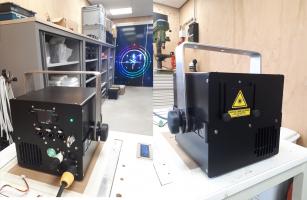Laserking uses a beamsplitter plate instead of a PBS to combine 2 lasers of the same color.Here,s a link of CNI how it exactly works:in comparison with the very smart minds working on this issue...I am a " Very Small Dog" indeed.....but I thought I would throw in a tidbit...
In response to the comment by LS==>" I had thought it may be possible in theory to use a long glass parallelogram to accomplish the combining. The difference would be the entering beams would be exactly parallel and "stacked" next to each other when entering the glass. ".....Please see the attached pic of the internals of a " LaserKing " projector...OK....if you are done laughing....you must admit they have tried a novel beam combining approach approach !! I have no details as to what the beam propagations are....except that a long glass parallelogram is employed to combine both red and blue diodes.
http://www.cnilaser.com/Polarization...er%20plate.htm
and a small picture......




 Reply With Quote
Reply With Quote
